Standard [CURRENT]
ASTM F 3601:2023
Standard Practice for Structural Finite Element Model Verification and Validation
- Publication date
- 2023
- Original language
- English
- Pages
- 4
- Publication date
- 2023
- Original language
- English
- Pages
- 4
- DOI
- https://dx.doi.org/10.1520/F3601-23
Product information on this site:
Quick delivery via download or delivery service
Buy securely with a credit card or pay upon receipt of invoice
All transactions are encrypted
Short description
1.1 This practice provides guidance for verification and validation of structural finite element models (FEMs) that are used to support showings of compliance with Civil Aviation Authority (CAA) regulations. This encompasses FEM predictions of internal loads, displacements, strains, stresses, stability, and post-buckling loads. 1.2 This practice applies to normal category aeroplanes with a certified maximum take-off weight of 19 000 lb (8618 kg) or less and a passenger seating configuration of up to 19. Use of the term aircraft throughout this specification is intended to allow the relevant CAA(s) to accept this practice as a means of compliance for other aircraft as they determine appropriate. 1.3 Code verification for FEM software is not included in the scope of this practice. It is expected, however, that the developer of software that is used to support showings of compliance has applied appropriate software quality assurance and numerical algorithm verification processes, including benchmark cases, to verify the accuracy and consistency of the solutions. Evidence of these activities should be recorded and documented and made available to the applicant and CAA upon request. 1.4 The applicant for a design approval should verify CAA acceptance of this practice before using it to support showings of compliance. For information on which CAA regulatory bodies have accepted this practice (in whole or in part) as a means of compliance to airworthiness standards: normal category aeroplanes (hereinafter referred to as "the Rules"), refer to the ASTM F44 webpage (www.ASTM.org/COMMITTEE/F44.htm), which includes CAA website links. 1.5 The values stated in inch-pound units are to be regarded as standard. The values given in parentheses are mathematical conversions to SI units that are provided for information only and are not considered standard. 1.6 This standard does not purport to address all of the safety concerns, if any, associated with its use. It is the responsibility of the user of this standard to establish appropriate safety, health, and environmental practices and determine the applicability of regulatory limitations prior to use. 1.7 This international standard was developed in accordance with internationally recognized principles on standardization established in the Decision on Principles for the Development of International Standards, Guides and Recommendations issued by the World Trade Organization Technical Barriers to Trade (TBT) Committee.
ICS
49.020
DOI
https://dx.doi.org/10.1520/F3601-23
Also available in
Loading recommended items...
Loading recommended items...
Loading recommended items...

